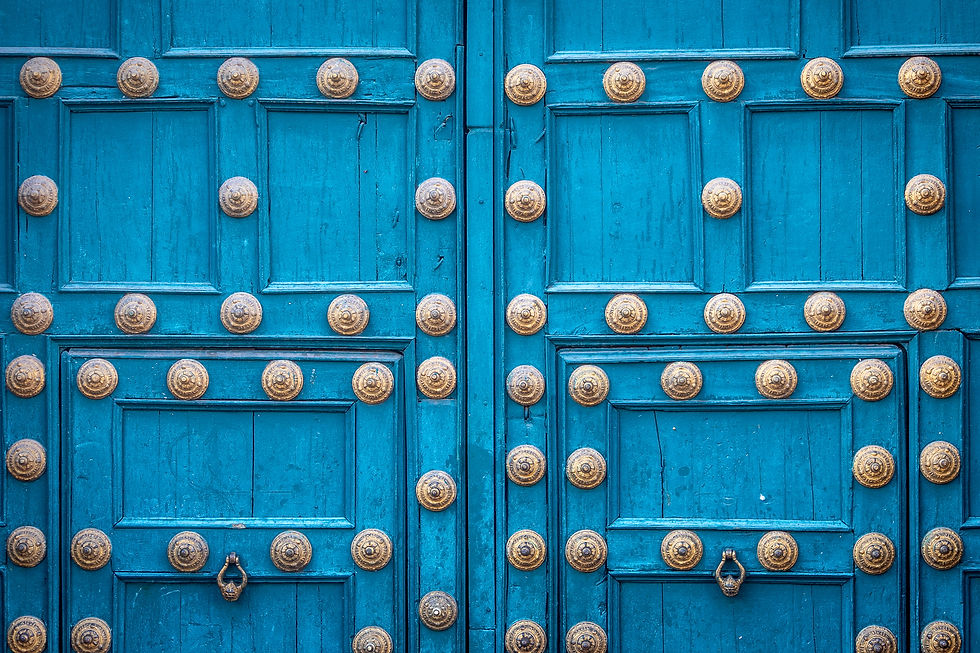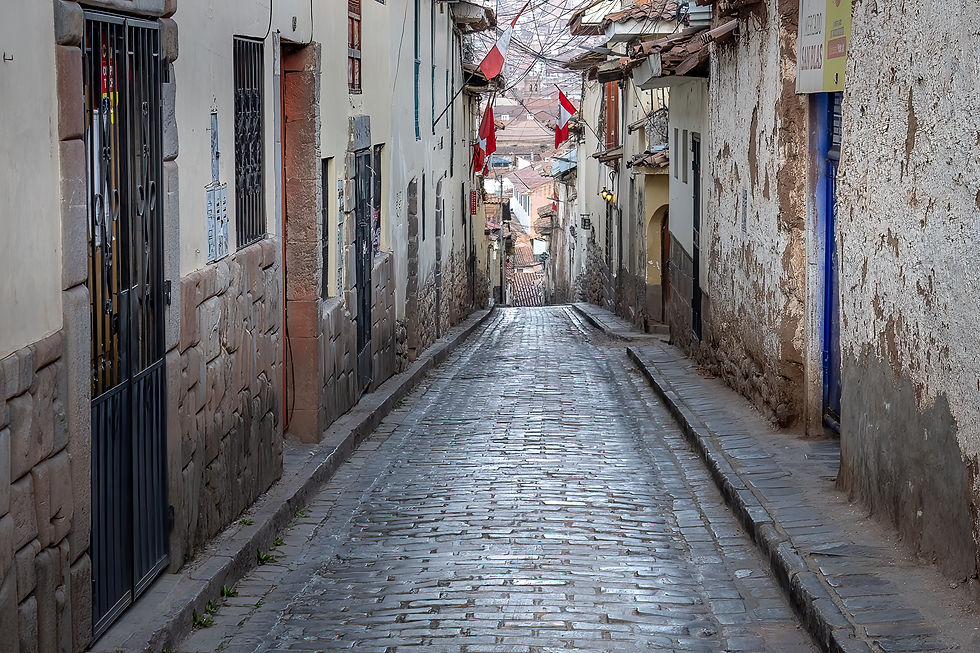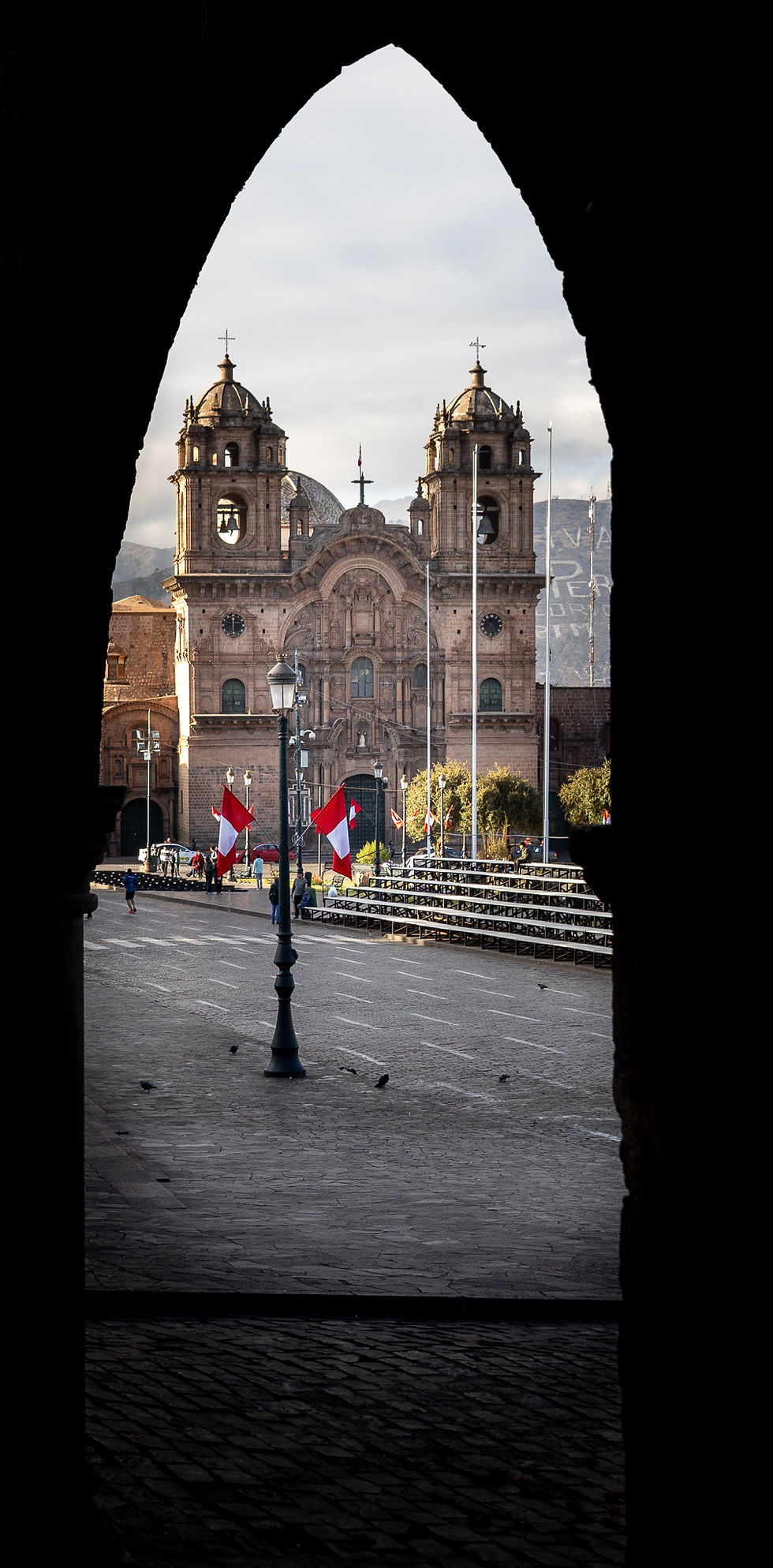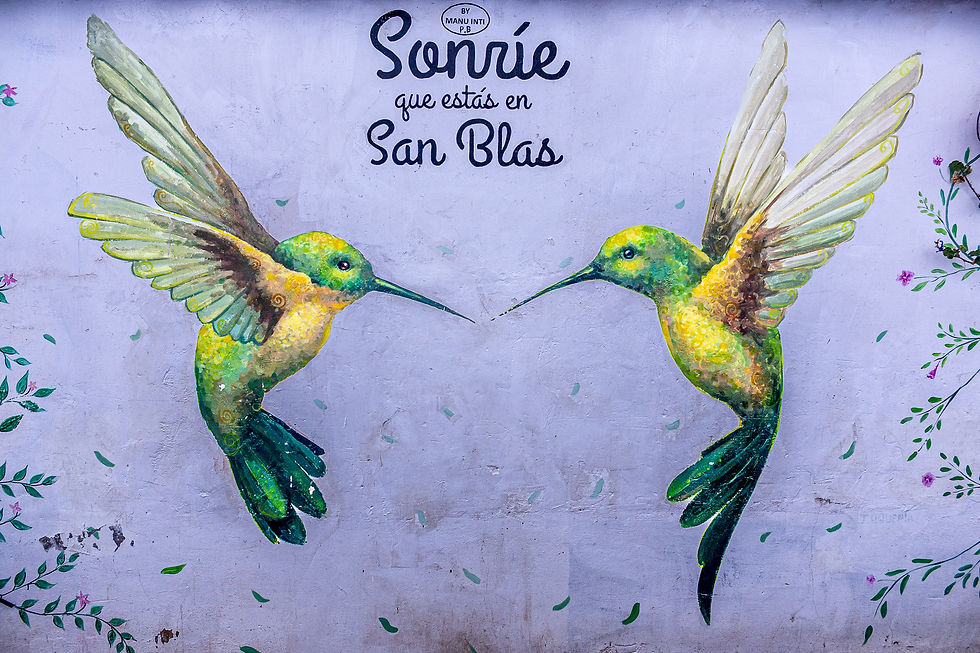Nuts and Bolts: Travel Tips for Visiting Cusco
- Rand Blimes

- Jun 18
- 13 min read
Updated: 2 days ago

Nuts and Bolts posts give you the practical information you need, but without stripping away the humor, mishaps, and little victories that make real travel what it is. These aren’t just guides. They’re how we actually did it—mistakes, triumphs, and all.
This page has some travel tips for visiting Cusco to aid in planning your own trip. I travel mainly with my wife, and we love to simply wander and eat when we explore a new place. We were in Cusco in July, 2024. If your trip to Cusco is significantly longer/shorter/with a different focus, you may have a very different experience.
Cusco: More Than Just a Pit Stop
Cusco is more than just the place you pass through on your way to Machu Picchu. It was once the capital of the Inca Empire, and it still feels like the cultural heart of Peru. With its vibrant food scene, charming neighborhoods, colonial architecture, museums, and enough trinket-packed shops to fill a dozen suitcases, it absolutely deserves time on your itinerary.
That said, it doesn’t need all your time.
We spent seven days in Cusco, then two more at Machu Picchu, then came back for another four days in Cusco. That’s eleven total for Cusco. In hindsight, it was overkill. We ended up skipping Arequipa entirely, and if we could do it again, we’d shift about half of those Cusco days south.
Our take: four or five days in Cusco is plenty (not including a couple of days to do Machu Picchu). Long enough to enjoy the sights, soak in the culture, and acclimate to the altitude—without running out of things to do (or developing strong opinions about the best place to buy a keychain shaped like an alpaca).
So, here is some basic advice on visiting Cusco:

Travel Tips for Visiting Cusco: Weather
Cusco has two seasons: wet and dry—with the dry season being, unsurprisingly, the better time to visit if you don’t enjoy hiking in ponchos and squinting through mist at what was allegedly a world wonder.

The dry season runs from May to September, and this is prime time for travelers. Clear skies, cooler nights, and warm (but not sweltering) days make for great conditions whether you’re wandering cobblestone streets or gasping your way up to a mountaintop ruin. This is also the busy season, so you’ll share the beauty with plenty of fellow admirers.
The wet season hits from November through March, and when it rains, it doesn’t mess around. Roads get muddy, trails can close, and sudden downpours can turn your perfect photo op into a watercolor painting. That said, the crowds thin out, and the landscapes turn a lush, electric green. If you don’t mind some meteorological drama, it can still be a great time to visit.
April and October are the shoulder months—weather can be mixed, but you might catch a sweet spot with fewer people and decent skies. Just keep your rain jacket handy. And maybe your sense of humor.
Dealing with the Altitude in Cusco
Cusco sits at about 3,400 meters, which is high enough to make your lungs file a formal complaint if you rush into things. For many travelers, this is their first real experience with altitude—and while most people adjust just fine, the first 24–48 hours can feel a little off.
The best strategy? Take it easy when you arrive. No sprinting up stairs. No packing your first day with uphill hikes and ambitious sightseeing. Wander slowly. Sit often. Breathe intentionally. Your body needs time to adjust to the thinner air.
Stay hydrated. It’s the simplest thing you can do to help your system cope. Drink water even if you’re not thirsty, and maybe go a little easy on heavy meals your first night. Your stomach is at altitude too.
If you want extra help adjusting, Diamox (acetazolamide) is available over the counter at most pharmacies in Cusco. It’s commonly used to prevent or ease symptoms of acute mountain sickness. It’s not a magic fix, but for some travelers, it makes a noticeable difference. Talk to your doctor before your trip or ask a pharmacist in town.
Most importantly, listen to your body. Headaches, mild dizziness, and fatigue are common and usually pass with rest. But if symptoms get severe—trouble breathing, confusion, loss of coordination—it’s time to head to a lower elevation and seek medical help. Altitude is no joke, but with some basic precautions, you’ll be fine. Probably.

Getting to and from Cusco
Unless you’re already perched somewhere high in the Andes, chances are you’ll be coming into Cusco from Lima—and your two main options are to fly or brace yourself for a very long bus ride.
Flying from Lima is by far the most efficient choice. It takes about 1 hour and 20 minutes, and multiple airlines (LATAM, Sky, JetSmart, etc.) offer several flights daily. Prices are often affordable, especially if you book early and avoid Peruvian holidays. Just keep in mind that weather delays are not uncommon—mountain airports play by their own rules. Especially in the wet season, try to build time for delays into your schedule.
If you're feeling adventurous—or particularly patient—you can take a bus from Lima to Cusco. Be warned: it’s 20–24 hours, winding through some of Peru’s most scenic and nausea-inducing roads. On the plus side, it’s cheaper, and companies like Cruz del Sur offer surprisingly comfortable “luxury” bus options. On the minus side: 24 hours. On a bus.
From Arequipa, you can either fly (1 hour) or bus (10–12 hours). The route between Arequipa and Cusco is long but scenic, passing through the Altiplano and often including a stop in Juliaca. Not a bad choice if you’re building a loop through southern Peru.
From Puerto Maldonado (the closest access to the Peruvian Amazon to Cusco), you can also fly (1 hour) or bus (10–12 hours). This is a popular route for people combining jungle and mountains in the same trip. The bus ride is dramatic—crossing from rainforest to highlands—but not always kind to those who suffer from motion sickness. Or those sitting next to someone who suffers from motion sickness.
In short: fly if you can, bus if you must, and bring a sense of humor either way. This is Peru. The scenery’s great. The altitude’s high. And the road is almost never boring.
Getting Around Cusco
Cusco is one of those cities where walking is both the best option—and occasionally a workout you didn’t sign up for. The historic center is compact and mostly walkable, with narrow cobblestone streets, colonial plazas, and pedestrian alleyways winding through it all. You can reach most major sites—like the Plaza de Armas, San Blas, and the local markets—on foot. Just remember: what looks like a short walk on the map might also be a steep staircase that makes you question your life choices at 3,400 meters.
If you're headed farther out—or just need a break from the verticality—Uber does work in Cusco. It’s generally affordable, though don’t expect lightning-fast service. Rides can take a while to arrive, and traffic in certain parts of town can turn a quick trip into a drawn-out crawl. Still, for reaching the airport, bus station, or the outskirts of town, Uber is a convenient option. If you don’t want to compete with everyone else on your flight for an Uber from the airport, you can pre-book a transfer through your hotel, or platforms such as Get Your Guide.
Taxis are also readily available and inexpensive, but always agree on a price before getting in—Cusco taxis don’t use meters.
Bottom line: walk when you can, ride when you must, and take your time. Cusco was built for exploration, not speed.
Sleeping in Cusco for the Budget Conscious Traveler
When it comes to choosing a hotel in Cusco, location matters—a lot. You’ll want to stay somewhere within walking distance of both the Plaza de Armas (the heart of the city) and San Blas (Cusco’s most charming and most self-consciously artsy neighborhood). Just keep in mind: San Blas sits uphill, and the Plaza de Armas sits downhill. No matter where you stay, you’ll be walking uphill one way and downhill the other. That’s just Cusco cardio.
San Blas is full of character—narrow cobbled alleys, whitewashed walls, blue balconies, and a vibe that screams “Instagram me.” It also comes with a higher price tag and a healthy dose of traveler pretentiousness. If you like sipping craft juice while listening to someone talk loudly about ayahuasca ceremonies, you’ll feel right at home.

For the first half of our stay, we based ourselves just outside of San Blas at the Allincay Cusco Apart Hotel, which we booked on Agoda. It was perfect. Quiet, comfortable, and a very short walk from all the San Blas charm—without the noise or the prices. Highly recommend.
For the second half of our stay, we tried Quechua Hotel, near the San Pedro Market. The location was great—easy access to the market, local restaurants, and a magnificent church—but I’d suggest giving this place a pass. It was one of several places in Peru that pulled the old bait and switch: showing glossy booking photos of one room, then putting us in a completely different one. When we pointed it out at the front desk, we got a smile, a shrug, and exactly zero help. To top it off, our bathroom had a mysterious stench wafting up through the shower drain. Not strong enough to make us leave early, but definitely strong enough to keep us counting the days until departure.
Eating in Cusco
Cusco is a tourist town, which means the food scene is wide, creative, and sometimes wildly inconsistent. There are plenty of solid options if you know where to look—and a few that are popular mostly because of their location or Instagramability. Here are some places we tried (and liked) during our ten-day stay:
Inka Grill – Right on the Plaza de Armas, which usually sets off alarm bells—but the food here is fresh, delicious, and authentically Peruvian. A great option if you want a traditional meal without wandering far from the action.
Morena Peruvian Kitchen – A bit more creative, with fusion-style twists on classic dishes. Also: very good churros and milkshakes. Make a reservation through their website, because it fills up.
Inkazuela – We liked this place enough to go back. Twice. The food is good, the setting is relaxed. Try to snag a table by the window overlooking the little square.
Uchu Peruvian Steakhouse – If you're going to try alpaca (and you really should), this is a good place to do it. The steaks are tender, flavorful, and beautifully presented. That said, you’ll find alpaca at plenty of other places around town too—Uchu just does it particularly well.

Cicciolina – Craving pizza? This is your spot. It’s wood-fired, rustic, and satisfying. Don’t expect Naples, but if you need a break from potatoes and quinoa, Cicciolina delivers.
Pachapapa – This is one of Cusco’s most well-known spots for traditional Peruvian food. It’s popular for a reason, but that also means crowds. Get a reservation or prepare to wait. We had fantastic papas rellenas (stuffed potatoes) here, but the rest of the meal didn’t stand out. If you’re deciding between Pachapapa and Inkazuela, walk the extra five minutes to the latter.
Nick’s Food Co. – This one’s a surprise. I couldn’t tell what it was at first—Indian? Mexican? Something called Tacomania? Maybe Korma Sutra? Turns out, it’s all of the above, crammed into a tiny, funky hole-in-the-wall at the edge of San Blas. We tried both the Indian and the Mexican dishes on two different visits, and both were excellent. This was our favorite cheap eats in Cusco.

A Word About Cuy (Guinea Pig):
We came to Peru fully prepared to eat cuy, despite once owning a guinea pig named Gigi. But we never ended up trying it. Every place that offered it seemed to treat it more as a tourist dare than a local delicacy. It was usually expensive, slow to prepare, and came with a vibe that said, “You’re not going to like this, but it’ll make a great story.” So we passed. And honestly? We don’t feel like we missed out.
What To Do in Cusco
Can You Visit Machu Picchu as a Day Trip from Cusco? Technically Yes. Should You? Probably Not.
Let’s get this out of the way: yes, it is technically possible to visit Machu Picchu as a day trip from Cusco. But it’s a long, hectic, high-stakes kind of day—and honestly, you’re probably better off planning to spend at least one night in Aguas Calientes (the town at the base of Machu Picchu).
Here’s what the day trip would look like: You’d need to catch an early morning train from Cusco to Aguas Calientes, then take transportation (usually a shuttle bus) up the mountain to Machu Picchu itself. After touring the site—likely while fighting off hunger, fatigue, and altitude—you’d need to reverse the entire process: bus back down, catch your return train, and get back to Cusco. All in one day.
Doing this independently is especially tricky. You could find yourself waiting in a long, slow-moving line for the general buses from Aguas Calientes up to Machu Picchu—and that wait can cut deeply into your already narrow window. If you’re absolutely set on a day trip, your best bet is to book an organized tour that handles all the logistics: train tickets, site entry, transportation, and maybe even lunch.
But really, if you can swing it, spend the night in Aguas Calientes. Give yourself a bit of breathing room. Seeing Machu Picchu shouldn’t feel like a rushed errand—it should feel like a moment.

In Cusco Itself
Here is a short list of some of the things you can spend your time on in Cusco.
Wander the Alleys of San Blas
This is Cusco’s most photogenic neighborhood—narrow cobblestone alleys, whitewashed walls, bright blue balconies, and an ever-present scent of espresso and patchouli. There are tons of little shops and galleries, most of which sell the same collection of hats, trinkets, and “handmade” alpaca gear. Still, it’s fun to poke around, and the neighborhood vibe is a highlight in and of itself.
Plaza San Blas
A small plaza perched on the hillside, it offers great views over the city, especially at sunset. It’s quieter than the main square, and a good place to take a break from the uphill trekking you didn’t know you signed up for.

The 12-Angled Stone
A brief stop, but worth a look. This famous Inca-cut stone is tucked into a wall near the Archbishop’s Palace and is celebrated for its perfect, mortarless fit. You’ll recognize it by the crowd of people taking photos and the guy dressed as an Inca posing for tips nearby. If nothing else, this stone is worth seeing just to marvel at how the magic of travel makes things seem wondrous.


Siete Borreguitos and the Aqueduct
This charming, slightly hidden street features a colonial-era aqueduct, flowerbox-covered buildings, and often a handful of friendly locals with lambs (or baby alpacas) for photo ops (for which you will pay a “tip”). Yes, it’s touristy. But it’s also atmospheric and unexpectedly lovely.
Mirador de Plaza San Cristóbal
One of the best panoramic viewpoints in Cusco. From here, you can see the rooftops spilling down the hillsides and the Plaza de Armas in full layout. Great photo spot—especially if you're trying to capture the sheer scale of the city.
Plaza de Armas
The heart of historic Cusco. Full of colonial architecture, restaurants, and street performers, it’s also home to the Cusco Cathedral and the Church of the Society of Jesus—two beautiful buildings well worth a peek inside. The plaza is always lively and makes a perfect home base for exploring the rest of the city.
Qorikancha
Once the most important temples in the Inca empire, Qorikancha was covered in gold before the Spanish arrived, stripped it, and built a Dominican convent on top. The resulting site is a fascinating blend of Inca stonework and colonial architecture, and an essential stop for anyone interested in the collision of cultures.
Mercado Central de San Pedro
Cusco’s main market is an overwhelming, glorious mix of food stalls, juice vendors, spices, crafts, and mystery meats. You can buy everything from dried corn to wool socks to a full roasted pig’s head. It’s chaotic, colorful, and one of the best places to glimpse local life.
San Francisco Convent Museum and Catacombs
This slightly off-the-beaten-path spot offers peaceful courtyards, historic paintings, and—yes—catacombs. It’s less polished than the big-name sites, but that’s part of the appeal. And unlike Lima’s catacombs, you won’t have to battle a crowd. Probably.
Cristo Blanco
A large white statue of Christ standing on a hill above the city, a bit like a miniature Rio. It’s worth the hike (or drive) up, especially because you can combine it with a visit to nearby Sacsayhuamán.
Sacsayhuamán
An Inca fortress and one of the most impressive archaeological sites in Cusco—massive stone walls fitted together with jaw-dropping precision. The scale is incredible, and the location provides stellar views over the city.
Museums in Cusco
Cusco has a lot of museums, though the quality varies. Here are a few that stand out:
Museo de Arte Precolombino – A beautiful space showcasing pre-Columbian art and artifacts, with excellent curation and design. One of the city’s best.
Museum of Monastic Life – Housed in the Santa Catalina convent, it offers a quiet and atmospheric look into religious life in colonial Peru.
Museo Inka – A classic spot for those looking to understand Inca history and culture in more depth. Some excellent artifacts, though the layout is a bit dated.
Choco Museo – Near the Plaza de Armas. They offer chocolate-making workshops, though you won’t be making chocolate from scratch. You’ll learn about cacao, pour chocolate into molds, add toppings, and come back a few hours later to collect your creations. Fun, tasty, and surprisingly informative.
Day Trips from Cusco
If you have time, Cusco is also a fantastic base for day trips into the surrounding mountains and valleys.

Rainbow Mountain – There are now two different sites with multicolored mineral striations drawing visitors. Vinicunca is the original, and Palccoyo is the easier, less crowded alternative. Either way, prepare for very high altitudes and early morning wake-up calls.
Ollantaytambo – An essential Inca site and one of the few places where you can still see a functioning Inca city layout. The ruins are huge and terraced dramatically into the mountainside.
Moray – Known for its circular agricultural terraces, possibly used by the Incas as an agricultural laboratory.
Maras Salt Mines – Thousands of shallow salt pools glinting in the sun, still harvested using ancient methods. The site is stunningly photogenic and fascinating to explore.Easy to visit with Moray.

Final Thoughts on Cusco
Cusco is the kind of place that grows on you—not because it’s easy or quiet or undiscovered, but because it holds so much history and humanity in such a compact, chaotic package. You’ll jostle through tourist crowds and wander silent ruins. You’ll walk uphill in thin air, find peace in unexpected corners, and maybe even learn a little travel magic along the way.
It’s not a city you need forever in. But it’s absolutely a place worth lingering in—for a few days, at least—just long enough to feel the texture of it beneath the tourism. Just long enough to remember that even the most popular places can still surprise you with a quiet plaza, a perfect view, or an oddly charming alpaca hat stand.
We didn’t need all eleven days here. But we’re glad we got to experience Cusco. Because travel isn’t just about efficient itineraries—it’s about giving yourself time to sit still and soak something in, even if you only realize the value of it after you’ve moved on.



Comments